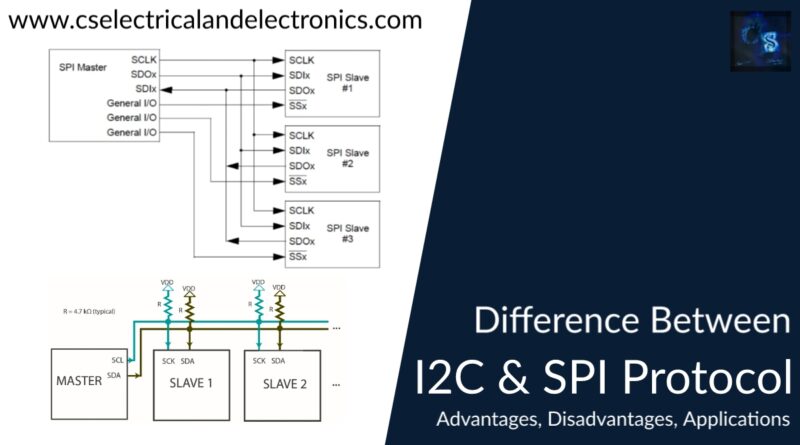Difference Between I2C And SPI Protocol, Which Is Best Protocol
Hello guys, welcome back to our blog. Here in this article, we will discuss the difference between I2C and SPI protocol, which protocol is best to use I2C or SPI, and we will also share the advantages, disadvantages, and applications of I2C and SPI.
If you have any electrical, electronics, and computer science doubts, then ask questions. You can also catch me on Instagram – CS Electrical & Electronics.
Also, read:
- What Is Round Robin In OS, Explanation, Source Code, Steps
- Top 10 Python Frameworks For Electrical And Electronics Engineers
- Bit Operation In C Programming With Example & Applications
Difference Between I2C And SPI Protocol
I2C Protocol
I2C (Inter-Integrated Circuit) is a serial communication protocol used for communicating with a variety of devices such as sensors, actuators, and other microcontrollers. It is a two-wire protocol, meaning it uses two wires for communication: a serial data line (SDA) and a serial clock line (SCL).
In I2C, there is a master device that controls the communication and one or more slave devices that receive commands from the master and send data back to it. The master device initiates communication by sending a start condition, which is followed by the 7-bit slave address and a read/write bit to indicate whether the master is reading data from the slave or writing data to it. The slave device responds with an acknowledgment bit to indicate that it received the address. The master and slave can then communicate by sending and receiving data bytes over the SDA line, with the SCL line being used to synchronize the communication. The communication is terminated with a stop condition.
I2C is a popular protocol due to its simplicity and low cost. It is widely used in a variety of applications including computer peripherals, automotive systems, and consumer electronics.
SPI Protocol
SPI (Serial Peripheral Interface) is a synchronous serial communication protocol used for communicating with peripheral devices such as sensors, actuators, and other microcontrollers. It is a four-wire protocol, meaning it uses four wires for communication: a clock line (SCLK), a slave select line (SS), a master output, a slave input line (MOSI), and a master input, a slave output line (MISO).
In SPI, there is a master device that controls the communication and one or more slave devices that receive commands from the master and send data back to it. The master device initiates communication by asserting the SS line for the slave device it wants to communicate with. The master and slave devices then exchange data over the MOSI and MISO lines, with the SCLK line being used to synchronize the communication. The communication is terminated when the master de-asserts the SS line.
SPI is a popular protocol due to its simplicity and high speed. It is widely used in a variety of applications including computer peripherals, automotive systems, and consumer electronics.
Note: There are also variations of the SPI protocol such as 3-wire SPI and Quad-SPI, which use fewer or additional lines for communication, respectively.
Difference between SPI and I2C Communication Protocol
There are several differences between the SPI and I2C communication protocols:
- A number of wires: SPI uses four wires for communication (SCLK, SS, MOSI, and MISO), while I2C uses only two wires (SDA and SCL).
- Communication mode: SPI is a full-duplex communication protocol, meaning that data can be transmitted and received simultaneously. I2C is a half-duplex communication protocol, meaning that data can only be transmitted or received at a given time.
- Data transfer rate: SPI has a higher data transfer rate compared to I2C, making it suitable for applications that require fast data transfer.
- Bus configuration: In SPI, there is a dedicated slave select line (SS) for each slave device, which the master uses to select the slave it wants to communicate with. In I2C, there is no such dedicated line, and the master uses the slave’s address to select the slave it wants to communicate with.
- Bus size: I2C can support a larger number of devices on the bus compared to SPI, as it uses a 7-bit address space, allowing for up to 128 devices. In contrast, SPI uses a single slave select line, meaning that the number of devices is limited by the number of available SS lines.
- Power consumption: I2C has a lower power consumption compared to SPI, as it can operate in a low-power mode and supports clock stretching, where the slave can hold the clock line low to extend the time between transfers.
In general, I2C is more suitable for low-speed, low-power applications, while SPI is better suited for high-speed applications. The choice between the two protocols depends on the specific requirements of the application.
Advantages, Disadvantages, and Applications of SPI
Advantages:
There are several advantages of the SPI protocol:
- High speed: SPI has a higher data transfer rate compared to other serial communication protocols such as I2C, making it suitable for applications that require fast data transfer.
- Full-duplex communication: SPI is a full-duplex communication protocol, meaning that data can be transmitted and received simultaneously. This allows for efficient communication between the master and slave devices.
- Simple hardware and software: The SPI protocol is simple to implement and requires minimal hardware, making it easy to use and requiring fewer resources compared to other protocols.
- Widely supported: SPI is a widely supported and well-established protocol, and many microcontrollers and peripherals support it. This makes it easy to find compatible devices and reduces the development effort required.
- Robustness: The SPI protocol is robust and can operate in noisy environments, making it suitable for use in industrial applications.
Overall, the SPI protocol is a simple and efficient way to communicate between devices, and it is widely used in a variety of applications including computer peripherals, automotive systems, and consumer electronics.
Disadvantages:
There are a few disadvantages of the SPI protocol:
- Four-wire interface: The SPI protocol requires four wires for communication, which can consume more resources (e.g., pins on a microcontroller) compared to protocols that use fewer wires (e.g., I2C, which uses only two wires).
- A limited number of devices: The SPI protocol uses a single slave select line (SS) to select the slave device, meaning that the number of devices that can be connected to the bus is limited by the number of available SS lines. In contrast, protocols such as I2C can support a larger number of devices on the bus.
- Complexity in multi-master systems: In multi-master systems, where multiple master devices are connected to the same bus, the SPI protocol can be more complex to implement compared to protocols such as I2C, which has built-in support for multi-master systems.
- No built-in support for device addressing: The SPI protocol does not have built-in support for device addressing, meaning that the slave devices must be identified using other means (e.g., using different SS lines or using a separate address register).
Overall, while the SPI protocol has several advantages, it may not be the best choice in all cases. The specific requirements of the application should be considered when choosing a communication protocol.
Applications:
The SPI (Serial Peripheral Interface) protocol is a widely used communication protocol in a variety of applications, including:
- Computer peripherals: The SPI protocol is commonly used to communicate with peripherals such as hard drives, printers, and displays.
- Automotive systems: The SPI protocol is used in automotive systems for communication between different controllers and sensors.
- Consumer electronics: The SPI protocol is used in a variety of consumer electronics such as smartphones, tablets, and other portable devices.
- Industrial automation: The SPI protocol is used in industrial automation systems for communication between controllers and sensors.
- Medical devices: The SPI protocol is used in medical devices such as pacemakers and glucose meters.
- Aerospace and defense: The SPI protocol is used in aerospace and defense systems for communication between different components and subsystems.
Overall, the SPI protocol is a widely used and well-established communication protocol, and it is suitable for a wide range of applications that require fast and efficient communication between devices.
Advantages, Disadvantages, and Applications of I2C
Advantages:
There are several advantages of the I2C (Inter-Integrated Circuit) protocol:
- Two-wire interface: I2C uses only two wires for communication (SDA and SCL), which can save resources (e.g., pins on a microcontroller) compared to protocols that use more wires (e.g., SPI, which uses four wires).
- Support for multiple devices: I2C can support a large number of devices on the bus, as it uses a 7-bit address space, allowing for up to 128 devices. This makes it suitable for applications with multiple devices that need to communicate with each other.
- Low power consumption: I2C has a lower power consumption compared to other protocols, as it can operate in a low-power mode and supports clock stretching, where the slave can hold the clock line low to extend the time between transfers. This makes it suitable for battery-powered and low-power applications.
- Multi-master support: I2C has built-in support for multi-master systems, where multiple master devices are connected to the same bus. This simplifies the implementation of multi-master systems compared to protocols such as SPI.
- Widely supported: I2C is a widely supported and well-established protocol, and many microcontrollers and peripherals support it. This makes it easy to find compatible devices and reduces the development effort required.
Overall, the I2C protocol is a simple and efficient way to communicate between devices, and it is widely used in a variety of applications including computer peripherals, automotive systems, and consumer electronics.
Disadvantages:
There are a few disadvantages of the I2C protocol:
- Half-duplex communication: I2C is a half-duplex communication protocol, meaning that data can only be transmitted or received at a given time. This can limit the efficiency of communication compared to protocols such as SPI, which is full-duplex.
- Lower data transfer rate: I2C has a lower data transfer rate compared to other protocols such as SPI, making it less suitable for applications that require fast data transfer.
- Complexity in multi-master systems: In multi-master systems, where multiple master devices are connected to the same bus, the I2C protocol can be more complex to implement compared to protocols such as SPI, which has built-in support for multi-master systems.
- Slower start-up time: The I2C protocol requires a start condition to be transmitted before communication can begin, which can add latency compared to protocols that do not have this requirement.
Overall, while the I2C protocol has several advantages, it may not be the best choice in all cases. The specific requirements of the application should be considered when choosing a communication protocol.
Applications:
The I2C (Inter-Integrated Circuit) protocol is a widely used communication protocol in a variety of applications, including:
- Computer peripherals: The I2C protocol is commonly used to communicate with peripherals such as hard drives, printers, and displays.
- Automotive systems: The I2C protocol is used in automotive systems for communication between different controllers and sensors.
- Consumer electronics: The I2C protocol is used in a variety of consumer electronics such as smartphones, tablets, and other portable devices.
- Industrial automation: The I2C protocol is used in industrial automation systems for communication between controllers and sensors.
- Medical devices: The I2C protocol is used in medical devices such as pacemakers and glucose meters.
- Aerospace and defense: The I2C protocol is used in aerospace and defense systems for communication between different components and subsystems.
Overall, the I2C protocol is a widely used and well-established communication protocol, and it is suitable for a wide range of applications that require simple and low-power communication between devices.
This was about the “Difference Between I2C And SPI Protocol“. I hope this article may help you all a lot. Thank you for reading.
Also, read:
- 100 + Electrical Engineering Projects For Students, Engineers
- 1000+ Electronics Projects For Engineers, Diploma, MTech Students
- 1000+ MATLAB Simulink Projects For MTech, Engineering Students
- 500+ Embedded System Projects For Engineer, Diploma, MTech, PhD
- 500+ Projects For Diploma Electrical, Electronics Student, Diploma Project
- 8051 Microcontroller Timers, TCON Register, TMOD Register
- Advancements In 3D Printing Technology And It’s Future
- Advancements In Power Electronics For Energy Efficiency
Author Profile
- Chetu
- Interest's ~ Engineering | Entrepreneurship | Politics | History | Travelling | Content Writing | Technology | Cooking
Latest entries
 All PostsApril 29, 2024Top 11 Free Courses On Battery For Engineers With Documents
All PostsApril 29, 2024Top 11 Free Courses On Battery For Engineers With Documents All PostsApril 19, 2024What Is Vector CANoe Tool, Why It Is Used In The Automotive Industry
All PostsApril 19, 2024What Is Vector CANoe Tool, Why It Is Used In The Automotive Industry All PostsApril 13, 2024What Is TCM, Transmission Control Module, Working, Purpose,
All PostsApril 13, 2024What Is TCM, Transmission Control Module, Working, Purpose, All PostsApril 12, 2024Top 100 HiL hardware in loop Interview Questions With Answers For Engineers
All PostsApril 12, 2024Top 100 HiL hardware in loop Interview Questions With Answers For Engineers








